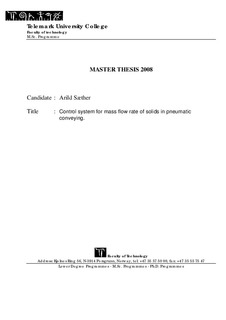| dc.description.abstract | The aim of the thesis is to make a model of the mass flow rate of solids in the pneumatic conveying systems situated at the POSTEC/Tel-Tek research facility to be used for the testing of model predictive control of these systems. An approach to use system identification is explained in the thesis, relating to energy density. The system identification method used was the subspace method "combined Deterministic and Stochastic Realization method" (DSR). The measurement data available was of transporting the bulk material baryte in dense phase for plant A and dextrose in dilute phase for plant B. Tests for plant A and B gave a cumulative error ranging from ±1.2-7.5% of total conveyed mass. This implies that the DSR model using the energy density approach could be used for dense phase conveying as well as dilute phase. It also implies that it could be applied to the same type of conveying system of different size and dimension. For the DSR model to estimate properly, the condition of close to constant energy into the pneumatic conveying line has to be fulfilled. The use of the DSR model based on the energy density approach, indicated relationships usable for later on making a rough mechanistic model. The disadvantage of the DSR model is that it has to have a measurement of the mass flow rate of solids for the calibration set. The MPC was simulated based on the test set data sets from plant B, transporting dextrose in dilute phase. The MPC was used as a validation method, seeking out how realistic the MPC optimal controls would act on the real process. The MPC simulations gave an indication that the main air is not accurate enough as a control input using the DSR model. At the moment the MPC is usable as a mass flow rate of solids adjustor, controlling the bypass air. | |
